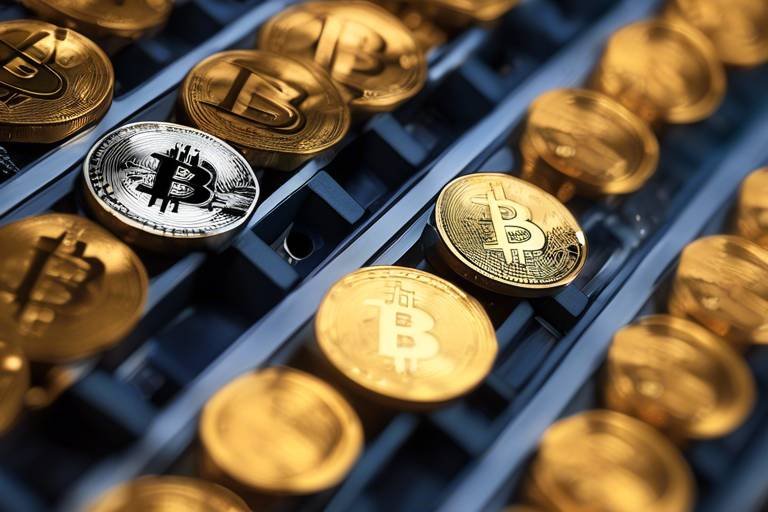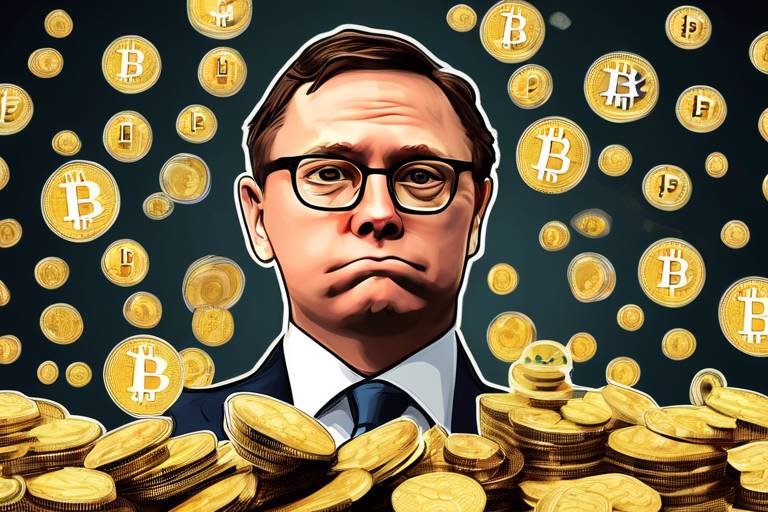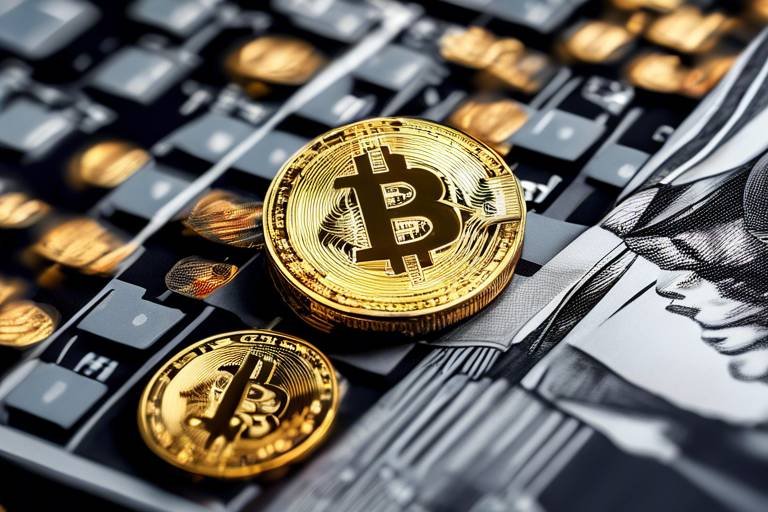Evaluating the Relationship Between Economic Stability and Crypto Prices
In today's fast-paced financial landscape, the connection between economic stability and cryptocurrency prices has become a hot topic among investors, analysts, and enthusiasts alike. As we delve into this relationship, it's crucial to recognize that the world of cryptocurrencies is not isolated; rather, it is intricately tied to broader economic trends. The performance of digital currencies can often mirror the health of traditional financial markets, creating a fascinating dance between the two realms.
When we talk about economic stability, we refer to a state where an economy experiences consistent growth, low inflation, and low unemployment rates. These factors play a pivotal role in shaping investor behavior and market trends. For instance, when economic conditions are favorable, investors tend to be more confident, leading to increased investment in both traditional assets and cryptocurrencies. Conversely, during periods of economic uncertainty, investors may flock to digital currencies as a hedge against potential downturns in the stock market.
But why should we care about this relationship? Well, understanding how economic stability influences crypto prices can provide us with valuable insights into market dynamics. It allows us to anticipate potential price movements and make informed investment decisions. Imagine trying to navigate through a storm without a compass; that’s what investing in cryptocurrencies can feel like without a grasp of the underlying economic factors at play.
Throughout this article, we will explore various components of economic stability, the impact of key economic indicators on cryptocurrency valuations, and the correlation between traditional markets and crypto assets. By the end of our journey, you will have a clearer picture of how these elements intertwine and influence one another, helping you navigate the often tumultuous waters of cryptocurrency investments.
Economic stability is more than just a buzzword; it encompasses a range of factors that contribute to the overall health of an economy. Key components include steady growth, low inflation, and low unemployment. When these elements align, they create a conducive environment for investment and consumer spending, which can positively affect asset prices, including cryptocurrencies.
The significance of economic stability in financial markets cannot be understated. A stable economy fosters investor confidence, leading to increased capital flow into various asset classes. In contrast, instability can breed uncertainty, prompting investors to seek refuge in alternative assets like cryptocurrencies. This is where the interplay between traditional markets and crypto becomes particularly intriguing.
Economic indicators serve as vital signposts for investors, providing insights into the health of an economy. Key indicators such as GDP growth, inflation rates, and employment statistics can significantly influence cryptocurrency valuations and market sentiment. For example, a robust GDP growth rate typically signals a thriving economy, which may lead to increased investment in riskier assets, including cryptocurrencies.
Inflation is a double-edged sword in the world of finance. On one hand, moderate inflation can stimulate economic growth; on the other hand, rising inflation erodes purchasing power. This dynamic plays a crucial role in shaping investment strategies. When inflation rates rise, investors may turn to cryptocurrencies as a hedge against the diminishing value of fiat currencies. In this sense, cryptocurrencies can be viewed as a modern-day equivalent of gold—an asset that retains value in times of economic uncertainty.
Hyperinflation is a phenomenon that can drive individuals towards cryptocurrencies as a store of value. Historical examples, such as Zimbabwe in the late 2000s or Venezuela in recent years, illustrate how rampant inflation can lead to a surge in crypto adoption. In these scenarios, people often turn to cryptocurrencies as a means of preserving their wealth when traditional currencies become unreliable.
On the flip side, deflation can create a challenging environment for both traditional and digital assets. When prices fall, consumer spending tends to decrease, leading to lower investment levels. This can erode investor confidence in cryptocurrencies, as they may be perceived as less attractive compared to traditional assets during deflationary periods. Understanding these pressures is essential for navigating the complex landscape of crypto investments.
Market sentiment is heavily influenced by economic events, and this is particularly true in the cryptocurrency space. News, policy changes, and economic forecasts can shape investor perceptions and reactions to crypto assets. For instance, announcements regarding regulatory changes or significant economic shifts can trigger rapid price fluctuations, making it imperative for investors to stay informed.
Analyzing the relationship between traditional financial markets and cryptocurrencies can provide valuable insights into price movements. It's essential to recognize that the two markets, while distinct, often respond similarly to economic stimuli. For example, during times of stock market volatility, we frequently see a ripple effect in the crypto space, with prices fluctuating in response to traditional market trends.
Volatility in stock markets often spills over into the crypto space, creating a symbiotic relationship between the two. When major stock market fluctuations occur, they can impact crypto prices and trading volumes. This interconnectedness highlights the importance of monitoring both markets to gauge potential price movements in cryptocurrencies.
Global economic events, such as financial crises or geopolitical tensions, can significantly affect crypto markets. Recent examples, such as the COVID-19 pandemic and its economic fallout, have illustrated how global events can lead to increased interest in cryptocurrencies as safe-haven assets. Understanding these dynamics is crucial for investors looking to navigate the ever-changing landscape of digital currencies.
- How does economic stability affect cryptocurrency prices?
Economic stability influences investor confidence, which can lead to increased or decreased investment in cryptocurrencies. - What role do inflation and deflation play in crypto valuation?
Inflation can drive demand for cryptocurrencies as a hedge, while deflation can decrease confidence in both traditional and digital assets. - Are cryptocurrencies a safe investment during economic downturns?
While some investors view cryptocurrencies as safe havens, their volatility can also pose risks during economic instability.

Understanding Economic Stability
Economic stability is a crucial pillar for any thriving economy. It refers to a state where an economy experiences consistent growth, low inflation, and minimal unemployment. Imagine a well-tuned engine: when all parts work harmoniously, the vehicle runs smoothly. Similarly, economic stability ensures that all sectors of the economy—businesses, consumers, and investors—function effectively. When stability is present, it fosters an environment where individuals feel confident in making long-term financial decisions, which is vital for investments in various assets, including cryptocurrencies.
To break it down further, the key components of economic stability include steady GDP growth, controlled inflation, and low unemployment rates. Each of these elements plays a role in shaping consumer confidence and market dynamics. For instance, when GDP is on the rise, it typically indicates that businesses are thriving, leading to job creation and increased spending power among consumers. On the flip side, if inflation rates are high, the purchasing power of money diminishes, making it harder for consumers to afford goods and services. This scenario can lead to a cautious approach to spending and investing, which can ripple through the economy and impact the crypto market.
Moreover, economic stability is significant in financial markets because it creates a predictable environment for investors. When investors can anticipate economic conditions, they are more likely to engage in riskier investments, such as cryptocurrencies. Conversely, in times of economic instability, investors might retreat to safer assets, such as gold or government bonds. This behavior highlights the delicate balance between economic conditions and market sentiment.
In essence, understanding economic stability is not just about knowing the numbers; it’s about grasping the broader implications of these factors on investment strategies and market behaviors. As we dive deeper into the relationship between economic stability and cryptocurrency prices, it becomes evident that the health of an economy can significantly influence the crypto landscape.

Impact of Economic Indicators on Crypto Prices
The relationship between economic indicators and cryptocurrency prices is a complex dance that can often leave investors scratching their heads. As we dive deeper into this topic, it becomes clear that various economic indicators—such as GDP growth, inflation rates, and employment statistics—play a pivotal role in shaping the landscape of crypto valuations. These indicators not only reflect the health of traditional financial markets but also offer insights into how cryptocurrencies might respond to shifts in the economy.
To start with, Gross Domestic Product (GDP) serves as a fundamental measure of economic performance. When GDP is on the rise, it typically signals a growing economy, which can lead to increased investor confidence. In such times, investors may feel more secure in allocating funds towards riskier assets, including cryptocurrencies. Conversely, a declining GDP can trigger fears of recession, prompting a flight to safety that often results in decreased demand for digital currencies. This correlation highlights how closely intertwined the fate of crypto assets is with traditional economic performance.
Next up is inflation, a term that can send shivers down the spine of even the most seasoned investors. Rising inflation erodes purchasing power, which can lead individuals to seek alternative stores of value. This is where cryptocurrencies come into play. When the cost of living increases and traditional currencies lose their value, many turn to digital currencies like Bitcoin as a hedge against inflation. For example, during periods of high inflation, we often see a surge in crypto demand, driving prices upward. On the flip side, if inflation rates stabilize or decrease, the urgency to invest in cryptocurrencies may wane, leading to potential price corrections.
Another key economic indicator is employment statistics. High employment rates generally signal economic stability, which can boost investor sentiment across the board. When people are employed and confident in their financial situations, they are more likely to invest in riskier assets, including cryptocurrencies. Conversely, rising unemployment can lead to economic uncertainty, prompting individuals to pull back on investments and focus on securing their finances. This shift in behavior can have a direct impact on crypto prices, creating volatility as investors react to changing economic conditions.
It's essential to consider how these economic indicators interact with one another. For instance, when inflation rises alongside high employment, it can create a unique scenario where consumer spending remains strong, keeping demand for cryptocurrencies buoyant. However, if inflation continues to rise unchecked, central banks may intervene by increasing interest rates, which can dampen investment in both traditional and digital assets. This intricate web of relationships underscores the importance of keeping an eye on economic indicators for anyone looking to navigate the crypto market effectively.
In summary, the impact of economic indicators on cryptocurrency prices is significant and multifaceted. Understanding how GDP growth, inflation rates, and employment statistics influence market sentiment can empower investors to make informed decisions. As the economic landscape continues to evolve, staying attuned to these indicators will be crucial for anyone looking to engage with the crypto space.
- How do economic indicators affect cryptocurrency prices? Economic indicators like GDP, inflation, and employment rates influence investor sentiment, which can lead to fluctuations in crypto valuations.
- What role does inflation play in cryptocurrency investment? Rising inflation can drive demand for cryptocurrencies as investors seek alternative stores of value, while low inflation may reduce interest in digital assets.
- Can employment rates impact the crypto market? Yes, high employment rates typically correlate with increased investor confidence, leading to more investments in cryptocurrencies, while rising unemployment can have the opposite effect.

The Role of Inflation
Inflation is a term that often sends shivers down the spine of investors and consumers alike. It represents the rate at which the general level of prices for goods and services rises, eroding purchasing power. But what does this mean for cryptocurrencies? Well, the relationship is quite intricate and fascinating. Inflation can significantly influence investor behavior and, consequently, cryptocurrency prices. When inflation rates rise, the value of traditional currencies tends to decline, prompting investors to seek alternatives that can potentially preserve their wealth.
One of the most compelling reasons why cryptocurrencies like Bitcoin and Ethereum gain traction during inflationary periods is their perceived role as a hedge against inflation. Just as gold has been a traditional safe haven, many view cryptocurrencies as a modern digital alternative. When fiat currencies lose their purchasing power, people often turn to digital assets to safeguard their investments. This shift in demand can lead to a surge in crypto prices, creating a ripple effect across the market.
But the relationship isn't always straightforward. For instance, if inflation is accompanied by rising interest rates, it can lead to a tightening of liquidity in the market. This situation could dampen enthusiasm for riskier assets like cryptocurrencies, causing prices to stagnate or even decline. Thus, the interplay between inflation and interest rates is crucial in understanding the broader economic landscape and its impact on crypto valuations.
To illustrate this dynamic, consider the following table that summarizes the potential impacts of inflation on cryptocurrency demand:
| Inflation Scenario | Investor Behavior | Impact on Crypto Prices |
|---|---|---|
| Rising Inflation | Increased interest in alternative assets | Potential price surge |
| Moderate Inflation | Stable demand for crypto | Steady prices |
| Hyperinflation | Flight to safety in digital assets | Significant price increase |
| Deflationary Pressures | Decreased spending, cautious investing | Possible price decline |
In summary, inflation plays a pivotal role in shaping the cryptocurrency market. It can drive demand for digital assets as investors seek refuge from the eroding value of fiat currencies. However, the effects of inflation are nuanced and can vary based on other economic indicators. Understanding these dynamics can empower investors to make informed decisions in a constantly evolving market.
- How does inflation affect cryptocurrency prices?
Inflation typically leads to increased interest in cryptocurrencies as investors look for alternatives to preserve their wealth, potentially driving prices up. - Can deflation impact cryptocurrency?
Yes, deflation can decrease spending and investment, leading to reduced confidence in both cryptocurrencies and traditional assets. - What role do interest rates play in this dynamic?
Rising interest rates during inflation can tighten liquidity, which may dampen enthusiasm for riskier assets like cryptocurrencies. - Are cryptocurrencies a good hedge against inflation?
Many investors view cryptocurrencies as a modern alternative to traditional safe havens like gold, especially during inflationary periods.

Hyperinflation and Crypto Adoption
Hyperinflation is a term that sends shivers down the spine of any economist. It refers to an extremely high and typically accelerating rate of inflation, often exceeding 50% per month. In such dire economic conditions, the traditional currencies lose their value at an alarming rate, making everyday transactions a daunting challenge. Imagine waking up one day and realizing that your money can barely buy a loaf of bread! This is where cryptocurrencies come into play, often seen as a lifeline for those trapped in a hyperinflationary spiral.
When hyperinflation strikes, people instinctively seek alternatives to protect their wealth. Cryptocurrencies, particularly Bitcoin, are often viewed as a safe haven during turbulent economic times. The decentralized nature of these digital assets provides a sense of security that traditional fiat currencies simply cannot offer. For instance, in countries like Venezuela and Zimbabwe, where hyperinflation has wreaked havoc on the economy, many individuals have turned to cryptocurrencies as a way to preserve their purchasing power.
Let's take a closer look at how hyperinflation can drive crypto adoption:
- Loss of Trust in Government: When hyperinflation occurs, citizens often lose faith in their government and its ability to manage the economy. This loss of trust can lead to a surge in interest in decentralized currencies that operate outside of government control.
- Accessibility: Cryptocurrencies can be accessed through smartphones and the internet, making them a viable option for individuals in countries with unstable banking systems.
- Global Transactions: Cryptocurrencies allow for seamless cross-border transactions, enabling individuals to escape the constraints of their local currency.
Historically, we've seen examples of hyperinflation leading to a surge in crypto adoption. In Venezuela, for instance, the bolívar has suffered from extreme devaluation, prompting citizens to turn to Bitcoin and other cryptocurrencies as alternatives. Reports indicate that many Venezuelans are using crypto not only for savings but also for everyday transactions, effectively bypassing the crumbling local economy. Similarly, during Zimbabwe's hyperinflation in the late 2000s, Bitcoin gained traction as a means of preserving wealth amidst rampant inflation.
However, it's essential to note that while hyperinflation can drive crypto adoption, it doesn't always guarantee long-term stability within the crypto market. The volatility of cryptocurrencies can be a double-edged sword, as their values can fluctuate dramatically even in times of economic crisis. Investors must weigh the potential risks and rewards carefully. In conclusion, hyperinflation serves as a powerful catalyst for crypto adoption, pushing individuals toward alternative financial solutions that offer a glimmer of hope in an otherwise bleak economic landscape.
- What is hyperinflation? Hyperinflation is an extremely high and accelerating rate of inflation, often leading to a rapid decrease in the purchasing power of a currency.
- How do cryptocurrencies help during hyperinflation? Cryptocurrencies provide a decentralized alternative to traditional currencies, allowing individuals to preserve their wealth and conduct transactions without relying on unstable local currencies.
- Can cryptocurrencies be a long-term solution in hyperinflationary environments? While they can offer short-term relief, the inherent volatility of cryptocurrencies may pose risks for long-term stability.

Deflationary Pressures
Deflation, the decline in general price levels, can create a challenging environment for both consumers and investors. When prices drop, people tend to hold onto their cash, anticipating even lower prices in the future. This behavior can lead to a vicious cycle of reduced spending and investment, ultimately stifling economic growth. In the world of cryptocurrencies, deflationary pressures can have a profound impact on investor confidence and market dynamics.
Imagine a scenario where a person is holding onto their Bitcoin, believing that its value will increase over time. However, if deflation sets in and the purchasing power of their cash grows, they might rethink their strategy. Why invest in an asset that could potentially lose value when cash seems to be a safer bet? This shift in mindset can lead to decreased demand for cryptocurrencies, causing prices to stagnate or even decline.
Moreover, deflation can create a paradox for cryptocurrency markets. While some cryptocurrencies are designed to be deflationary—meaning their supply decreases over time—this characteristic can become a double-edged sword. For instance, Bitcoin has a capped supply of 21 million coins, which can make it appealing during inflationary times. However, in a deflationary environment, the allure of holding onto a digital asset may diminish as people prioritize liquidity and immediate purchasing power.
To illustrate the effects of deflation on cryptocurrency, consider the following table that highlights key factors influencing investor behavior during deflationary periods:
| Factor | Impact on Investor Behavior |
|---|---|
| Decreased Spending | Investors may hold back on purchasing cryptocurrencies, fearing further price drops. |
| Increased Cash Demand | As cash becomes more valuable, investors may prefer to liquidate crypto assets for cash reserves. |
| Market Sentiment | Negative sentiment can lead to panic selling, exacerbating price declines. |
Additionally, the psychological aspect of deflation cannot be overlooked. When economic conditions are perceived as unstable, fear and uncertainty can drive investors away from riskier assets like cryptocurrencies. This shift in sentiment can create a feedback loop where falling prices lead to more fear, further driving down demand. As a result, the crypto market may experience heightened volatility, making it a challenging landscape for investors looking for stability.
In conclusion, deflationary pressures pose significant challenges for the cryptocurrency market. While some digital assets are designed to thrive in deflationary environments, the overall impact of decreased spending and increased cash demand can lead to a decline in crypto valuations. As investors navigate these turbulent waters, understanding the intricate relationship between deflation and cryptocurrency demand will be crucial for making informed investment decisions.
- What is deflation? Deflation is the decrease in the general price level of goods and services, which can lead to reduced consumer spending and investment.
- How does deflation affect cryptocurrency prices? Deflation can lead to decreased demand for cryptocurrencies as investors may prefer to hold cash, anticipating further price drops.
- Are cryptocurrencies a good investment during deflation? It depends on the specific cryptocurrency and the broader economic context. Some may thrive, while others may struggle.

Market Sentiment and Economic Events
Market sentiment is a powerful force in the world of cryptocurrencies, often swaying prices in ways that fundamental analysis alone cannot predict. When it comes to understanding how economic events shape investor perceptions, it's essential to consider that emotions play a critical role. For instance, sudden announcements about interest rate hikes or unexpected inflation figures can lead to rapid shifts in market sentiment, causing traders to react impulsively. This reaction can create a ripple effect, influencing not just the crypto markets but also traditional financial landscapes.
Take, for example, the impact of central bank policies. When a central bank signals a change in monetary policy, such as tightening or loosening interest rates, investors closely monitor these signals. A hawkish stance might lead to fears of economic slowdown, prompting investors to flee to perceived safe havens like gold or cryptocurrencies. Conversely, a dovish approach can boost risk appetite, leading to increased investment in higher-risk assets, including various cryptocurrencies. The relationship is not straightforward, though; it’s often a dance between fear and greed.
Moreover, news cycles play a significant role in shaping market sentiment. Major headlines, whether they involve regulatory changes, technological advancements, or security breaches, can send shockwaves through the crypto market. For instance, a favorable regulatory announcement can create a wave of optimism, pushing prices higher as new investors enter the market. On the flip side, negative news can trigger panic selling, resulting in sharp declines. This volatility highlights the fragile nature of market sentiment, which can be easily swayed by the latest headlines.
Economic events like financial crises or geopolitical tensions can also have profound effects on crypto prices. During times of uncertainty, cryptocurrencies are often viewed as alternative stores of value. For instance, during the economic turmoil caused by the COVID-19 pandemic, many investors turned to Bitcoin, viewing it as a hedge against inflation and currency devaluation. Such behavior underscores the importance of understanding the broader economic context when evaluating cryptocurrency investments.
To illustrate the relationship between market sentiment and economic events, consider the following table that summarizes key events and their effects on crypto prices:
| Economic Event | Date | Impact on Crypto Prices |
|---|---|---|
| COVID-19 Pandemic Announcement | March 2020 | Bitcoin surged as investors sought safe-haven assets. |
| US Federal Reserve Rate Cut | March 2020 | Increased interest in cryptocurrencies as inflation hedge. |
| China's Crackdown on Crypto Mining | June 2021 | Immediate drop in Bitcoin prices due to negative sentiment. |
| El Salvador Adopts Bitcoin as Legal Tender | September 2021 | Boosted Bitcoin prices amid optimism. |
In conclusion, understanding the interplay between market sentiment and economic events is crucial for anyone looking to navigate the often-turbulent waters of cryptocurrency investing. By keeping a pulse on economic indicators and news cycles, investors can better anticipate market movements and make informed decisions.
- How do economic events affect cryptocurrency prices? Economic events can influence investor sentiment, leading to price fluctuations based on fear or optimism.
- What role does news play in market sentiment? News can rapidly change market perceptions, causing either bullish or bearish trends in crypto prices.
- Can cryptocurrencies act as a hedge against economic instability? Yes, during times of economic uncertainty, many investors turn to cryptocurrencies as alternative stores of value.

Correlation Between Traditional Markets and Crypto
The relationship between traditional financial markets and cryptocurrencies is a complex yet fascinating one. As investors seek to diversify their portfolios, understanding how these two realms interact can provide valuable insights into price movements and market trends. The correlation between these markets can often be likened to a dance; when one moves, the other might follow, albeit with its own rhythm and pace. This dynamic is especially evident during periods of market volatility, where shifts in investor sentiment can lead to significant fluctuations in cryptocurrency prices.
To grasp this correlation, we must first consider the factors that link traditional markets to crypto. Major stock market fluctuations can have a ripple effect, influencing investor behavior across various asset classes, including cryptocurrencies. For instance, when the stock market experiences a downturn, investors may seek refuge in digital assets as a hedge against traditional market risks. On the flip side, a bullish stock market can lead to increased liquidity, prompting investors to explore the potential of cryptocurrencies, driving their prices higher.
Moreover, global economic events play a crucial role in shaping this correlation. Events such as financial crises, changes in monetary policy, or geopolitical tensions can create a sense of uncertainty that permeates both traditional and crypto markets. Take, for instance, the COVID-19 pandemic; it sent shockwaves through global economies, leading to massive sell-offs in stock markets while simultaneously sparking a surge in interest in cryptocurrencies as alternatives. This scenario illustrates how interconnected these markets can be, with investor sentiment acting as the common thread.
Interestingly, the correlation is not always straightforward. While some investors view cryptocurrencies as a separate asset class, others consider them a speculative extension of traditional investments. This dual perception can lead to varying degrees of correlation, which may change over time. For example, during times of economic stability, cryptocurrencies might move independently of traditional markets. However, during periods of heightened uncertainty, the correlation tends to strengthen, as investors flock to perceived safe havens.
| Market Condition | Impact on Traditional Markets | Impact on Crypto Markets |
|---|---|---|
| Market Downturn | Increased volatility, risk aversion | Potential increase in demand as a safe haven |
| Market Rally | Increased confidence, higher liquidity | Potential influx of investment into crypto |
| Global Crisis | Heightened uncertainty, panic selling | Increased interest as an alternative asset |
In conclusion, the correlation between traditional markets and cryptocurrencies is a multifaceted relationship influenced by various factors, including market sentiment, economic events, and investor behavior. As the financial landscape continues to evolve, staying attuned to these correlations will be essential for investors seeking to navigate the complexities of both worlds effectively.
- What is the primary factor that influences the correlation between traditional markets and crypto?
The primary factor is investor sentiment, which can shift based on economic conditions, market volatility, and global events. - Can cryptocurrencies act as a hedge against traditional market downturns?
Yes, during market downturns, some investors may turn to cryptocurrencies as a hedge, seeking stability in a volatile environment. - How do global economic events affect cryptocurrency prices?
Global economic events can create uncertainty, leading to shifts in investor behavior that impact both traditional and crypto markets.

Stock Market Volatility
When we talk about , we’re diving into a world where prices fluctuate wildly, sometimes in a matter of hours or even minutes. This volatility can send shockwaves through the financial system, and guess what? The cryptocurrency market is not immune to these tremors. In fact, the relationship between traditional stock markets and cryptocurrency prices is often intertwined, like a complex web of cause and effect. Imagine a pendulum swinging back and forth; when the stock market experiences significant fluctuations, the crypto market often reacts in kind.
To illustrate this connection, let’s consider a few key points. When the stock market tumbles due to negative news—be it an economic downturn, poor earnings reports, or geopolitical tensions—investors often flee to what they perceive as safer assets. This flight to safety can lead to a surge in demand for cryptocurrencies, particularly Bitcoin, which many view as a digital gold. Conversely, during bullish market conditions, where stocks are soaring, investors might divert their attention and capital away from crypto, leading to a decrease in demand and potential price drops.
Here’s a quick breakdown of how stock market volatility can impact crypto prices:
- Investor Sentiment: When stocks are volatile, it can create a sense of uncertainty among investors. This uncertainty can lead to increased interest in cryptocurrencies as an alternative investment.
- Liquidity Flows: Volatile stock markets can trigger rapid liquidity shifts, with capital moving in and out of assets, including cryptocurrencies, based on market conditions.
- Correlation of Assets: The degree of correlation between stocks and cryptocurrencies can vary, but during periods of high volatility, this correlation often strengthens.
Historically, we’ve seen this dynamic play out during major economic events. For instance, during the COVID-19 pandemic, stock markets around the globe experienced unprecedented volatility. As fear gripped traditional markets, many investors sought refuge in cryptocurrencies, leading to a significant price surge. This phenomenon highlights how intertwined these markets can be, with each influencing the other in real-time.
Moreover, the rise of institutional investment in cryptocurrencies has further blurred the lines between these markets. As hedge funds and large investment firms begin to allocate a portion of their portfolios to crypto assets, the correlation between stock market volatility and crypto prices may intensify. This raises a critical question: are we witnessing the emergence of a new asset class that behaves differently than traditional investments, or are cryptocurrencies merely reflecting the same underlying economic forces?
In conclusion, understanding the relationship between stock market volatility and cryptocurrency prices is essential for any investor looking to navigate these turbulent waters. The interplay between these markets is complex and ever-evolving, but one thing is clear: when stock markets shake, the crypto world often feels the tremors. As we continue to explore this fascinating landscape, it’s crucial to stay informed and adaptable, ready to respond to the shifts that can impact our investment strategies.
- What is stock market volatility? Stock market volatility refers to the rate at which the price of stocks increases or decreases for a given set of returns. It is often measured using statistical metrics like standard deviation.
- How does stock market volatility affect cryptocurrency prices? Volatility in the stock market can lead to changes in investor sentiment and liquidity flows, which in turn can impact demand and pricing for cryptocurrencies.
- Are cryptocurrencies a safe investment during stock market volatility? While some investors view cryptocurrencies as a hedge against traditional market fluctuations, they can also be highly volatile themselves, making them a risky investment.

Global Economic Events
Global economic events can act like a powerful ripple in a pond, creating waves that affect various markets, including the ever-evolving world of cryptocurrencies. For instance, when a financial crisis strikes, it doesn't just shake traditional markets; it sends shockwaves through the crypto space as well. Investors often look for safe havens during turbulent times, and cryptocurrencies can either be viewed as a risk or a refuge, depending on the context.
Take the 2008 financial crisis, for example. It was a pivotal moment that reshaped financial landscapes. As banks faltered and trust in traditional financial systems eroded, many turned their eyes toward alternatives like Bitcoin, which was born out of the desire for a decentralized currency free from governmental control. This event not only boosted Bitcoin's appeal but also set the stage for the entire cryptocurrency market to flourish.
Moreover, geopolitical tensions can also play a significant role in shaping crypto markets. For instance, when trade wars escalate or countries face sanctions, economic instability often follows. Investors, feeling the pinch, might pivot towards cryptocurrencies as a means to protect their assets. This shift can lead to sudden price surges in crypto assets, as demand spikes when traditional assets seem too risky.
To illustrate the impact of global economic events on cryptocurrency prices, consider the following table that outlines recent significant events and their effects on crypto valuations:
| Event | Date | Impact on Crypto Market |
|---|---|---|
| COVID-19 Pandemic | March 2020 | Initial market crash, followed by a surge in crypto investments as people sought alternatives. |
| US-China Trade War | 2018-2020 | Increased interest in Bitcoin as a hedge against economic uncertainty. |
| Russia-Ukraine Conflict | 2022 | Spike in crypto usage in Ukraine and surrounding regions as a means of fundraising and asset protection. |
As we can see from the above table, specific global events can lead to significant shifts in the cryptocurrency landscape. Investors are constantly assessing the risks associated with both traditional and digital assets, and their decisions can create volatile price movements. It's almost like a chess game, where every move in the global economy can lead to strategic shifts in the crypto market.
In conclusion, understanding the interplay between global economic events and cryptocurrency prices is crucial for investors. By keeping an eye on these events, one can better anticipate market movements and make informed decisions. After all, in the world of finance, knowledge is power, and being aware of the broader economic picture can help you navigate the often unpredictable waters of cryptocurrency investing.
- How do global economic events affect cryptocurrency prices?
Global economic events can create uncertainty, prompting investors to seek alternative assets like cryptocurrencies, which can lead to price fluctuations. - What role does investor sentiment play during economic crises?
During economic crises, investor sentiment can shift dramatically, affecting how cryptocurrencies are perceived—either as a safe haven or a risky investment. - Can geopolitical tensions influence crypto adoption?
Yes, geopolitical tensions often lead to increased adoption of cryptocurrencies, as individuals seek to protect their wealth from unstable currencies and economies.
Frequently Asked Questions
- How does economic stability affect cryptocurrency prices?
Economic stability plays a crucial role in shaping the demand for cryptocurrencies. When an economy is stable, investors may feel more confident in traditional assets, which can lead to a decrease in crypto investments. Conversely, during times of economic uncertainty, people often turn to cryptocurrencies as a hedge against inflation or instability, driving prices up.
- What economic indicators should I watch to predict crypto price movements?
Key economic indicators include GDP growth rates, inflation rates, and employment statistics. For instance, a rising inflation rate can diminish purchasing power, prompting investors to seek alternative assets like cryptocurrencies. Keeping an eye on these indicators can provide insights into potential shifts in the crypto market.
- How does inflation impact cryptocurrency investments?
Inflation can significantly influence investor behavior. When inflation rises, the value of traditional currency decreases, which often leads investors to cryptocurrencies as a store of value. This shift can increase demand and subsequently drive up prices. On the other hand, falling inflation may lead to decreased interest in crypto as investors feel more secure in traditional investments.
- What is the relationship between traditional markets and cryptocurrencies?
There is often a correlation between traditional financial markets and cryptocurrencies. For example, volatility in the stock market can spill over into the crypto space, leading to increased trading volumes and price fluctuations. Understanding this relationship can help investors make more informed decisions.
- Can global economic events influence cryptocurrency prices?
Absolutely! Global economic events, such as financial crises or geopolitical tensions, can have a profound impact on cryptocurrency valuations. These events often lead to increased uncertainty, prompting investors to either flock to or away from crypto, depending on their perceptions of risk and opportunity.
- What role does market sentiment play in cryptocurrency pricing?
Market sentiment is a powerful driver of cryptocurrency prices. News, policy changes, and economic forecasts can shape how investors feel about the market. Positive news can lead to bullish trends, while negative news can trigger panic selling, illustrating how closely tied crypto prices are to overall market sentiment.



















